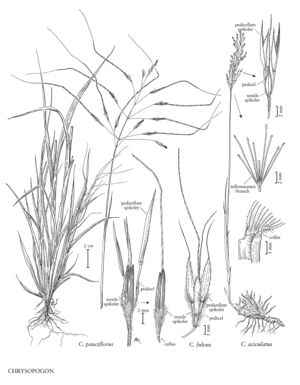Difference between revisions of "Chrysopogon pauciflorus"
FNA>Volume Importer |
imported>Volume Importer |
||
| (6 intermediate revisions by 2 users not shown) | |||
| Line 26: | Line 26: | ||
-->{{#Taxon: | -->{{#Taxon: | ||
name=Chrysopogon pauciflorus | name=Chrysopogon pauciflorus | ||
| − | |||
|authority=(Chapm.) Benth ex Vasey | |authority=(Chapm.) Benth ex Vasey | ||
|rank=species | |rank=species | ||
| Line 33: | Line 32: | ||
|basionyms= | |basionyms= | ||
|family=Poaceae | |family=Poaceae | ||
| + | |illustrator=Linda A. Vorobik;Annaliese Miller | ||
| + | |illustration copyright=Utah State University | ||
|distribution=N.C.;Fla.;Tex. | |distribution=N.C.;Fla.;Tex. | ||
|reference=None | |reference=None | ||
| Line 38: | Line 39: | ||
|publication year= | |publication year= | ||
|special status= | |special status= | ||
| − | |source xml=https:// | + | |source xml=https://bitbucket.org/aafc-mbb/fna-data-curation/src/200273ad09963decb8fc72550212de541d86569d/coarse_grained_fna_xml/V25/V25_1540.xml |
|subfamily=Poaceae subfam. Panicoideae | |subfamily=Poaceae subfam. Panicoideae | ||
|tribe=Poaceae tribe Andropogoneae | |tribe=Poaceae tribe Andropogoneae | ||
Latest revision as of 17:57, 11 May 2021
Plants annual. Culms 60-110 cm, erect or somewhat decum¬bent. Sheaths glabrous; ligules membranous, ciliolate; blades to 31 cm long, 4-10 mm wide, flat or folded, mostly or completely glabrous, adaxial surfaces some¬times with scattered pubescence at the base. Panicles 20-30 cm, open; branches 5-8 cm, capillary, strongly divergent; rames usually a triplet of spikelets. Sessile spikelets 8.1-10 mm; calluses about 7 mm, sharp; glumes smooth below, scabrous distally; lower glumes shortly awned or mucronate from the sinuses of the minutely bilobed apices; upper lemmas awned, awns 10.6-16 cm, geniculate, twisted below. Pedicellate spikelets 7.2-15 mm. 2n = unknown.
Distribution
N.C., Fla., Tex.
Discussion
Chrysopogon pauciflorus is native, but infrequently encountered, in the southeastern United States, primarily in Florida; it also occurs in Cuba. It grows in flatwoods, abandoned fields, pinelands, marsh edges, and various disturbed sites.
Selected References
None.
